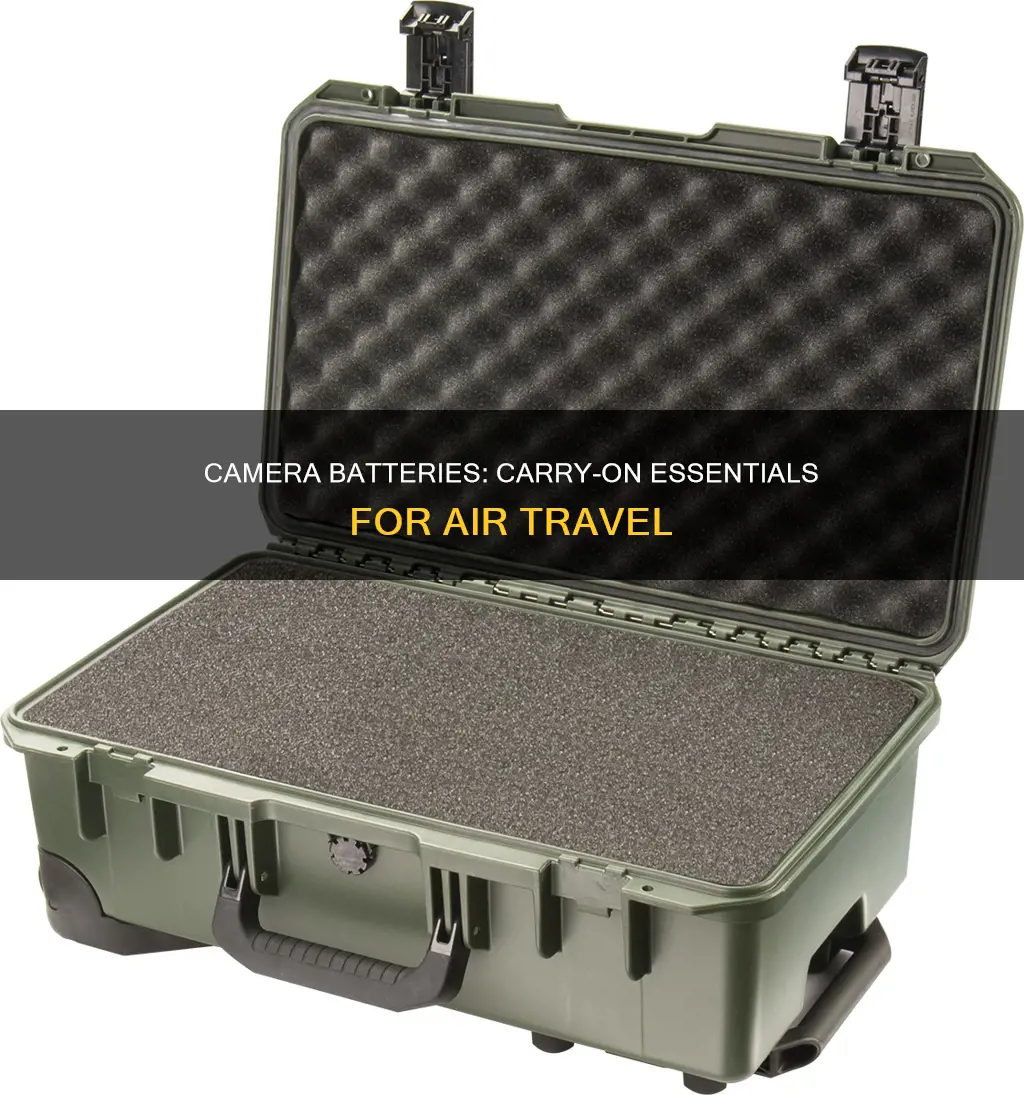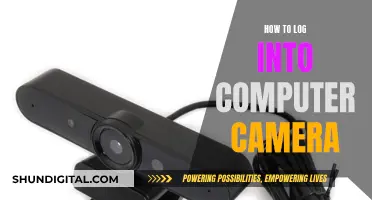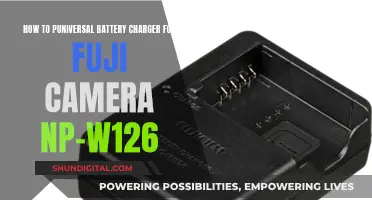
Camera batteries are considered dangerous goods due to their potential to short-circuit or catch fire, so there are strict guidelines for their transportation on airplanes. Most camera batteries are lithium-ion batteries, which are permitted in carry-on luggage but prohibited in checked baggage. This is because, in the event of a fire, cabin crew can intervene and stop the fire. Passengers are advised to protect battery terminals to prevent short circuits and tape over the charging interface or connectors. There are limits on the number and size of lithium-ion batteries that can be carried on board, and batteries must not be damaged.
| Characteristics | Values |
|---|---|
| Type of batteries | Standard dry cell alkaline batteries (AA, AAA, C, and D), lithium-ion batteries, lithium metal batteries |
| Where to keep them | Carry-on luggage |
| Quantity | No limit for standard dry cell alkaline batteries. Two spare batteries for lithium-ion and lithium metal batteries |
| Weight/Watt-hour limit | 100-watt hours for lithium-ion batteries, 2 grams of lithium for lithium metal batteries |
| Protection | Battery terminals should be protected with tape or manufacturer's packaging. Keep them in separate bags |
| Damaged batteries | Not allowed |
What You'll Learn
- Lithium-ion camera batteries under 100Wh are allowed in carry-on luggage
- Lithium-ion camera batteries over 100Wh may be allowed with airline certification
- Lithium-ion camera batteries must be shielded from damage and short circuits
- Lithium-ion camera batteries must be carried in carry-on luggage only
- Each passenger is limited to two spare lithium-ion camera batteries

Lithium-ion camera batteries under 100Wh are allowed in carry-on luggage
As a photographer, you will almost certainly want to take your camera batteries with you when you fly abroad. However, it's important to be aware of the specific rules and guidelines in place for carrying camera batteries on planes.
When packing lithium-ion camera batteries for air travel, it is crucial to protect the battery terminals to prevent short circuits. This can be done by using the manufacturer's packaging or covering the terminals with tape. It is also recommended to place each battery in its own protective case, plastic bag, or package. Additionally, passengers should be aware that there is a limit of two spare lithium-ion batteries per passenger.
To ensure compliance with the regulations, it is advisable to check the specific guidelines of the relevant aviation authorities, such as the FAA, TSA, EASA, or IATA, as well as the policies of the airline you are travelling with. These guidelines and policies are subject to change, so staying up to date is essential.
By following the relevant regulations and guidelines, photographers can safely transport their lithium-ion camera batteries under 100Wh in their carry-on luggage when flying.
Charging the Wimius Q4: A Step-by-Step Guide
You may want to see also

Lithium-ion camera batteries over 100Wh may be allowed with airline certification
Lithium-ion camera batteries are a common power source for many electronic devices, including cameras. These batteries have a high energy density and are susceptible to thermal runaway, which can lead to overheating and even combustion. As a result, aviation authorities have implemented specific regulations to ensure the safe transport of these batteries.
When it comes to flying with lithium-ion camera batteries, the regulations specify that batteries within 100Wh are generally permitted in carry-on luggage without any special approval. These batteries are typically considered safe and can be easily managed by cabin crew in the event of a fire. However, it is important to note that these batteries should be protected from damage and short circuits during transport. This can be achieved by storing them in their original packaging or covering the charging interface with tape.
For lithium-ion camera batteries over 100Wh, the regulations become more stringent. While these batteries are not explicitly prohibited, they require special approval from the airline to be allowed on board. Each airline may have its own specific policies and guidelines regarding the transport of larger lithium-ion batteries, so it is crucial for passengers to confirm the regulations with their chosen airline before their trip.
To obtain airline certification for lithium-ion camera batteries over 100Wh, passengers should contact the airline directly and provide detailed information about the batteries they intend to carry. This includes specifications such as the battery's watt-hour rating, quantity, and intended use. The airline will then assess the information provided and determine whether the batteries can be safely transported on their aircraft.
It is important to note that even with airline certification, there may be restrictions on the number of larger lithium-ion batteries allowed per passenger. According to the Federal Aviation Administration (FAA), passengers may carry up to two spare lithium-ion batteries between 101 and 160 Wh with airline approval. These batteries should also be protected from short circuits by covering the terminals or using the manufacturer's packaging.
Charging the Eufy Solar Camera: A Quick Guide
You may want to see also

Lithium-ion camera batteries must be shielded from damage and short circuits
Lithium-ion batteries are commonly used in cameras and other electronic devices, such as smartphones, laptops, and tablets. These batteries are considered a safety risk due to their potential for rapid combustion, so specific regulations and guidelines must be followed when travelling with them. Here are some detailed instructions on how to shield lithium-ion camera batteries from damage and short circuits when flying:
- Use the original packaging: Store the batteries in their original packaging, which is designed to protect them from damage and short circuits. If you don't have the original packaging, use a protective case.
- Tape the battery terminals: Cover the charging interface or terminals with tape to prevent accidental activation and short circuits. You can use camera tape to avoid leaving sticky residue on the batteries.
- Place batteries in separate bags: To enhance safety, store each battery in a separate bag to ensure they don't come into contact with each other or other metal objects.
- Limit the number of batteries: Check the specific regulations of your airline, but generally, you are allowed to carry two spare lithium-ion camera batteries in your carry-on luggage.
- Keep batteries with you: Always carry lithium-ion camera batteries in your carry-on luggage. Do not put them in checked baggage or checked luggage, as they could pose a fire hazard if there is no one available to intervene.
- Check battery condition: Do not bring damaged, defective, or recalled batteries on the plane. If a battery shows signs of swelling or leakage, dispose of it properly and purchase a new one.
- Follow airline guidelines: Different airlines may have different policies and limitations regarding the type, quantity, and capacity of lithium-ion batteries allowed. Always check with your airline before your trip to ensure you are following their specific guidelines.
- Comply with international laws: International laws for air travel prohibit carrying lithium batteries in the hold of an airplane. All lithium-ion camera batteries should be carried in your hand luggage.
- Be mindful of weight limits: Lithium-ion camera batteries can be heavy, so be mindful of the weight limits for carry-on luggage. Distribute your equipment across multiple bags if necessary to stay within the weight limits.
Recharging Olympus Camera Batteries: A Step-by-Step Guide
You may want to see also

Lithium-ion camera batteries must be carried in carry-on luggage only
When flying with camera equipment, it's important to be aware of the regulations surrounding lithium-ion camera batteries. Here are some detailed instructions and guidelines to ensure your compliance and safety:
Lithium-ion Camera Batteries:
Lithium-ion batteries are commonly found in cameras, smartphones, laptops, and other electronic devices. Due to their potential for rapid combustion, civil aviation authorities have implemented specific rules for their transportation.
Carry-on Luggage Only:
Lithium-ion camera batteries must be carried in your carry-on luggage only. This regulation is in place to ensure the safety of the flight. In the event of a fire, cabin crew and passengers can intervene and mitigate the situation. Keeping these batteries with you is crucial, as loose lithium batteries in the cargo hold can pose a significant fire hazard.
Quantity and Capacity Restrictions:
Each passenger is typically limited to carrying two spare lithium-ion camera batteries. For lithium-ion batteries, the watt-hour limit per battery is 100 Wh. However, with airline approval, you may carry up to two additional larger batteries (101-160 Wh). It's important to check with your airline beforehand to confirm their specific limitations.
Safe Packaging:
To prevent short circuits, protect the battery terminals by using the manufacturer's packaging or covering the terminals with tape. You can also place each battery in a separate bag for added protection. Additionally, make sure the batteries are protected from damage and kept away from metal objects to avoid accidental activation.
International Regulations:
These regulations regarding lithium batteries apply to most countries, including the USA and the UK. It's worth noting that individual airlines may have their own restrictions, so it is essential to verify the rules of your chosen airline before your trip.
Other Battery Types:
Standard dry cell alkaline batteries, such as AA, AAA, C, and D, can be freely carried in carry-on luggage or checked baggage without any restrictions. However, they must still be protected from damage and prevented from creating sparks or excessive heat.
In summary, when flying with lithium-ion camera batteries, always carry them in your carry-on luggage, abide by the quantity and capacity restrictions, ensure safe packaging, and stay informed about international and airline-specific regulations. By following these guidelines, you can ensure the safe transportation of your camera equipment.
How to Keep Your WiFi Camera Charged and Ready
You may want to see also

Each passenger is limited to two spare lithium-ion camera batteries
When flying with camera equipment, it's important to keep your gear safe, comply with legal requirements, and be mindful of any additional costs. This is especially true if you're travelling with a lot of equipment.
Lithium-ion batteries, which are commonly found in cameras, smartphones, laptops, and tablets, are considered a fire hazard by aviation authorities. As such, there are strict rules in place regarding their transportation.
According to the Federal Aviation Administration (FAA), spare lithium-ion camera batteries must be carried in your carry-on luggage. This is because, in the event of a fire, the cabin crew can intervene and stop it. The FAA also states that devices containing lithium-ion batteries should be kept in carry-on baggage. If these devices are packed in checked baggage, they should be turned off, protected from accidental activation, and packed securely.
It is important to note that regulations may vary depending on the airline and your destination, so it is always a good idea to check with your airline before your trip to ensure you are complying with their specific policies. Additionally, laws and policies regarding the transportation of lithium-ion batteries are subject to change, so staying up-to-date with the latest regulations is crucial.
Vivint Doorbell Camera: Battery or Wired?
You may want to see also
Frequently asked questions
Yes, camera batteries are allowed in carry-on luggage. However, there are specific rules enforced by aviation authorities, like the FAA or EASA, regarding the type and quantity of batteries you can bring.
Standard dry cell alkaline batteries (AA, AAA, C, and D) and installed lithium-ion batteries are typically permitted without any restrictions on quantity. For lithium-ion batteries, the limit is often set at 100-watt hours per battery, while for lithium metal batteries, it is 2 grams of lithium per battery.
Yes, there may be quantity restrictions depending on the type of battery. Each passenger is usually limited to two spare lithium-ion or lithium metal batteries. There is no limit on the number of standard dry cell alkaline batteries you can bring.
Yes, it is important to protect the battery terminals to prevent short circuits. You can use the manufacturer's packaging or cover the terminals with tape. Placing batteries in separate bags provides additional protection. Additionally, some regulations advise taping over the metal contacts on batteries to prevent short-circuiting.







